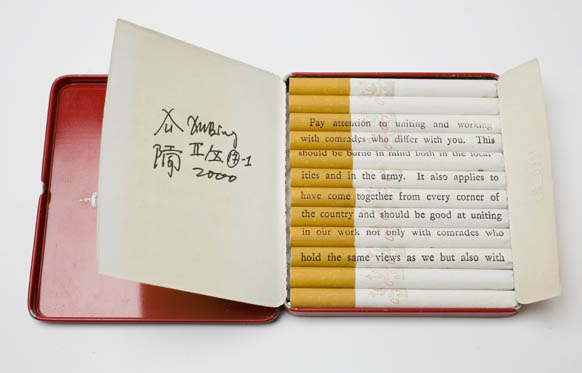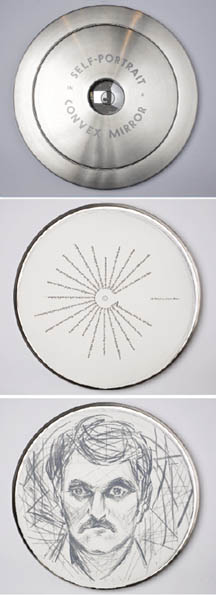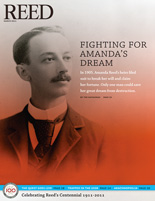
IRIS login | Reed College home Volume 90, No. 1: March 2011
The Book Unbound

DON’T SMOKE THE ART. Xu Bing painstakingly stamped quotations from Chairman Mao onto these Zhonghua cigarettes (yes, they’re real tobacco) to create his Tobacco Project: Red Book. Self-published, 2000.Photos by Orin Zyvan
Reed’s amazing artists’ books.
By Lucy Bellwood ’12

GOING TUBULAR. This edition of John Ashbury’s Self Portrait in a Convex Mirror pushes the concept of “book” to its limit. Published in a hand-spun stainless steel canister, it features an actual convex mirror. The poem is set in radiating lines, so that the pages must be rotated (turned—get it?!) in order to read the piece. The book also includes a stone lithograph portrait by Elaine de Kooning. Arion Press, 1984.
Everyone knows the quintessential Reedie is a devout bibliophile, but when it comes to adoration, what are the limits? The cover? The pages? The content? Can the book stand alone as a work of art? What if it’s made of soap or printed with squid ink? What is it, really, that makes a book a book?
The answers lie deep in the bowels of the Hauser Library behind the unassuming wooden door of the Pierce Room, which guards an unexpected cave of treasures: Persian rugs, mahogany desks, and bronze busts. But the eye is drawn to the strange objects on the shelves. Here’s a bold red cigarette case, opened to reveal excerpts from Mao’s Little Red Book painstakingly stamped onto individual cigarettes. Here’s a massive steel film canister, its contents a series of circular self-portraits by luminary artists and poets. The surrounding shelves positively bristle with volumes sporting irregular pages and sculpted spines, all crafted from a wealth of unorthodox materials—and all bent on answering the same set of questions.
Welcome to the Artists’ Books collection—a rich, eccentric assembly of works, which all, in some way, blur the boundaries between literature, fine art, craft, and interactive sculpture. Headed by professor Gerri Ondrizek [art, 1994–], the collection includes nearly 1,200 titles, each one a variation on the possibilities of the book as a sculptural object. Ondrizek has been building the collection since 1996, when she first became interested in the Artist’s Book movement while on sabbatical. “The books are here to push the boundaries of fine art and challenge my students to explore the possibilities of creating pieces that draw upon the astonishingly rich tradition of the printed word,” she explains.
The Artist’s Book movement began in the early twentieth century with a shift toward exploring the boundaries of the book as a new medium of artistic expression. Since then, publishers, painters, political activists, and poets have all explored the idea, collaborating with one another to produce works from highbrow fine-press editions to cheap subversive pamphlets.
Over the last decade, there has also been a resurgence of interest in traditional bookbinding and printing techniques, but Ondrizek is quick to distinguish the purpose of Reed’s collection from this broader trend. “I’m interested in developing it as an extension of the art world, rather than a demonstration of the craft of binding or letterpress,” she clarifies. “These are all works that we feel will push the students to think differently about their own artistic processes and the boundaries of fine art.”
Ondrizek wanted to bring the artist’s book into the curriculum at Reed, but felt challenged by this problematic position in the hierarchy of the art world. The proponents of “Fine Art,” she says, have traditonally claimed that art is “not a book, or a box, or fashion, or design—but by reinventing a traditionally academic, intellectual item as the basis for a new field of sculptural pieces, we can fight that.” At the outset, the task was challenging due to the lack of available teaching materials. “There are articles on the subject,” she admits, “but you read literature on this stuff and just have no idea what it is you should be looking at—it’s so hard to describe! But if you can actually see the object and touch it, the experience is transformed.” In 1997, the art department gave Ondrizek the go-ahead to purchase Collective Farm, the collection’s first volume, and a new resource was born.
Ondrizek currently teaches Art 368, “Image and Text: the Artist’s Book as a Sculptural Object” every three years. The class recently marveled over Takako Saito’s Book Chess No. 1, an interactive chessboard contained in a minimalist pale wooden box and populated by tiny letterpressed black and white booklets that serve as pieces. Since there are no distinguishing marks on the outsides of the booklets to identify the pieces, forgetful players must read out the text printed inside—generally a poem, proverb, or quotation—in order to rediscover their identity. Halfway through a gambit, one might pause to read the following quotation from Emperor Charles V: “To God I speak Spanish, to women, Italian, to men, French, and to my horse, German.”
There are, of course, challenges to working with such unusual material. “If you’re showing 18 students one tiny book, it can be hard to take it in and talk about it,” Ondrizek notes. “So we began looking for ways to enhance the collection—to let everyone spend time with the pieces.” In 2008, she worked with Marianne Colgrove ’84 [digital wizardry, 1989–] and a small army of students to develop an online gallery, complete with 16 fully-photographed books, biographies of the artists, further reading lists, and contextual information, all written and complied by students.
The collection has drawn a lot of attention from the local community. Some of the most significant and intriguing books recently enjoyed display at an exhibition at the Museum of Contemporary Craft. Instructors from Portland State University, the Pacific Northwest College of Art, and Portland Community College have made it part of their curriculum. “It’s become a crucial resource for students and artists throughout the Portland area,” says Reed’s special collections librarian Gay Walker ’69. “There’s simply nothing else like it here.”
Ultimately, Ondrizek sees the Artist’s Book as an avenue for communication. “A book can contain things, it can be a private, personal space,” she muses, sculpting a box in the air with her hands, “but I can also hand it to the next person—it’s like a room you can walk into. A potent distillation of experience.” After spending some time with the powerful physical artifacts in the collection, it’s hard to disagree.


LATEST COMMENTS
steve-jobs-1976 I knew Steve Jobs when he was on the second floor of Quincy. (Fall...
Utnapishtim - 2 weeks ago
Prof. Mason Drukman [political science 1964–70] This is gold, pure gold. God bless, Prof. Drukman.
puredog - 1 month ago
virginia-davis-1965 Such a good friend & compatriot in the day of Satyricon...
czarchasm - 4 months ago
John Peara Baba 1990 John died of a broken heart from losing his mom and then his...
kodachrome - 7 months ago
Carol Sawyer 1962 Who wrote this obit? I'm writing something about Carol Sawyer...
MsLaurie Pepper - 8 months ago
William W. Wissman MAT 1969 ...and THREE sisters. Sabra, the oldest, Mary, the middle, and...
riclf - 10 months ago